 
GRAPHIC VARIATIONS
Sequential Cartoons
If single-panel cartoons in Modern Sketch frame discrete moments of their era, multi-panel cartoon strips narrate the era by manipulating the reader’s experience of time. This is because the cartoonist’s art of paneling, or arranging images in a sequence, in effect “tells” time by inviting the reader to interpolate what happens between one panel and the next.[1] Filling in the panel-to-panel gaps to create a smooth narration—a mental process known as closure—allows the reader to “construct a continuous, unified reality.”[2] As to how the reader constructs that reality, myriad factors come into play. Most fundamental, of course, is the reader’s familiarity with cartooning conventions.[3] Other factors include accompanying text (such as titles, captions, or speech balloons), awareness of cultural and historical background, and above all, the cartoonist’s skill in manipulating imagery and words to construct a time-based visual narrative whose “unified reality” engages the imagination. Just as in the single-panel cartoon, the contributors to Modern Sketch experimented with variations on the multi-panel cartoon strip as a means to place their humorous and satirical stamp on the era.
|
 |
Wu Zhen
“Biological Heat Preference”
A straighforward way to indicate the passage
of time in a cartoon sequence is to simply include a
clock on the wall and a window onto the sky. The
item under the bed is a chamberpot.
March 1935 [ms15_032] |
| |
Normally—but as we shall see, not necessarily—it takes at least two panels to activate closure. Even the shortest of sequences, however, can ask for quite different kinds of narrative participation from the reader.
|
|
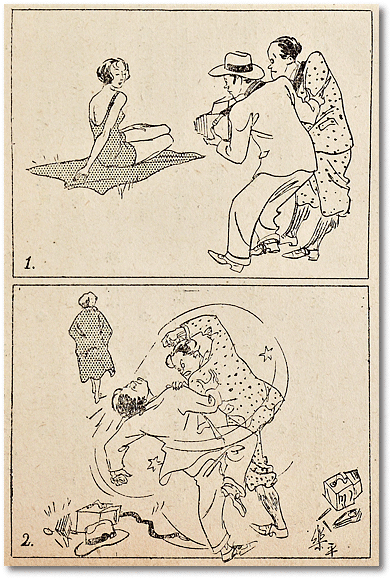 |
 For instance, when closure is determined by linking one action to another action, the implied time duration between panels can be very tight. Such is the case in Zhang Leping’s two-panel depiction of a pair of snappily dressed paparazzi who come to blows while fighting for the perfect shot of a celebrity bathing beauty. For instance, when closure is determined by linking one action to another action, the implied time duration between panels can be very tight. Such is the case in Zhang Leping’s two-panel depiction of a pair of snappily dressed paparazzi who come to blows while fighting for the perfect shot of a celebrity bathing beauty.
|

Zhang Leping
February 1934 [ms02_030] |
| |
By contrast, when the panel transitions not from action to action, but from one space and time to another, the interval “between” panels can leave much more to the imagination, because readers must work harder to deduce a logical linkage. The process of deduction, however, draws the reader into a potentially rich and evocative space of closure. In Modern Sketch, this was usually the space of social satire, as Feng Di demonstrates in a set of two-panel sequences under the collective title “Taking Full Charge.”
|
|
| |
 Work like a slave... Work like a slave...
...and the crows
take charge.
|
Graduation ceremony...
...and the street
takes charge. |
 Old-style marriage... Old-style marriage...
...and the lawyers take charge. |
 Pregnant... Pregnant...
...and the trash bin takes charge. |
|
Feng Di
“Taking Full Charge”
July 1936 [ms28_09] |
| |
Just how closure in Zhang’s and Feng’s cartoons engages these cartoonists’ era is, of course, the key question. As contributions to Modern Sketch, we can assume that they were accepted for publication because they captured some aspect of the modern era, and did so with a satirical flair intended to improve life through critique, as Lu Shaofei stressed in his guidelines for submission. In the case of Zhang’s cartoon, the motivation behind the comic violence that we infer breaking out between the panels is none other than the intensely sexualized commodification, through pictorial magazines as well as film and advertisement, of images of women—more of which we shall see below. In Feng’s very different sequence, building continuity between each upper and lower panel invites the reader to construct a much broader critical vision, one in which modern urban society has failed, socially and institutionally, to take moral responsibility for its members.
Accompanying text—in the form of a title, captions, or speech—can be critical to how we read most any cartoon sequence. Some Chinese cartoonists took good advantage of the space for humorous and satirical play when combining text with the effects of sequencing. The Canton-based cartoonist Jin Mo, for instance, deliberately frustrates expectations for closure by lining up three identical panels of an opium smoker. The sequence works as a narrative only because the three captions—“Smoking,” “Quitting,” “After Quitting”— do tell a story, but one in ironic tension with the repeated images. As for the depiction of the addict, Jin’s decision to draw a stereotypical “Chinese” figure with notably traditional hairstyle and clothes suggests that drug use is a national, rather than individual or even fully modern, issue. Between the irony and the iconicity, then, Jin’s sequence communicates both the intractability and prevalence of opium addiction. |
|
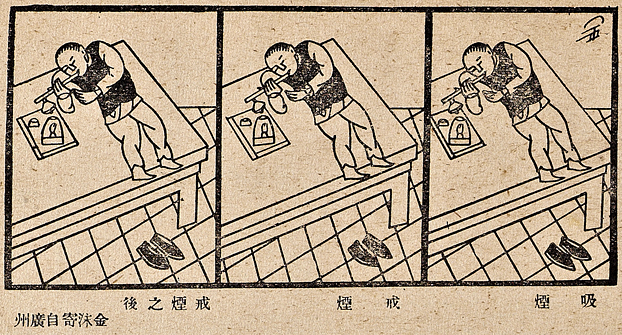 |
| |
Jin Mo
“Smoking,” “Quitting,” “After Quitting”
August 1935 [ms20_009]
|
|
| |
Viewed from today’s perspective, one may well ask to what extent Jin intended to criticize the use of opium, a substance vilified in China’s national narrative as a scourge upon the health of the national body. Again, as we saw with Jin Mo’s cartoon of the “salt-water sisters,” there is no simple solution to such a question, because its answer depends upon the response of the reader, which is in turn conditioned by historical changes to the rules of representation. Indeed, subsequent readers have found opium cartoons in Modern Sketch so politically incorrect that they felt the need to rectify them on the spot with their own accompanying text.
|
|
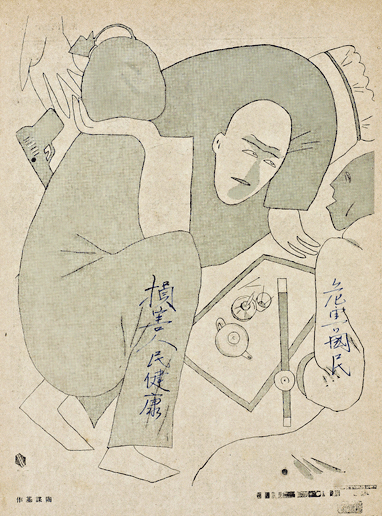 |
   We can see how this has happened to a cartoon by Tao Mouji. Above the admonitory but intentionally ironic slogan “Strictly Prohibit Opium,” Tao shows us an addict paying off an armed enforcer, likely a police officer, thus giving the lie to the period’s official anti-narcotic campaigns.[4] Unhappy with or perhaps even oblivious to Tao’s satirical intent, an anonymous previous owner of this copy of Modern Sketch felt obliged to write in with a fountain pen: “Damaging to the health of the people” and “Harmful to national citizens.” We can see how this has happened to a cartoon by Tao Mouji. Above the admonitory but intentionally ironic slogan “Strictly Prohibit Opium,” Tao shows us an addict paying off an armed enforcer, likely a police officer, thus giving the lie to the period’s official anti-narcotic campaigns.[4] Unhappy with or perhaps even oblivious to Tao’s satirical intent, an anonymous previous owner of this copy of Modern Sketch felt obliged to write in with a fountain pen: “Damaging to the health of the people” and “Harmful to national citizens.”
|
 Tao Mouji Tao Mouji
“Strictly Prohibit Opium”
October 1934 [ms10_016] |
| |
To return to the art of sequencing, another Canton-based cartoonist, Yu Yongpeng, uses a fixed-gaze approach not unlike Jin Mo’s to narrate the passage of time in his richly colored sequence “Competing Vehicles.” Here time is constructed in relation to the mechanization of modern urban life. Rickshaws themselves had become widespread in China’s treaty-port cities as a modern mechanical contrivance only around the turn of the century. Here, through gradual bleaching of hue from warm orange to bleak gray, the deterioration of the patient puller, and the proliferation of motorized public buses in the background, Yu’s sequence defines modernity as a process of merciless technological change.
|
|
| |
Yu Yongpeng
“Competing Vehicles”
December 1936 [ms33_022]
|
|
| |
Visual Narrative: Politics & Corruption
Cartoonists’ disgust with the fraud, vice, and official duplicity they saw around them was exceeded only by their delight in dreaming up ways to caricature those with power, from the Generalissimo himself, Chiang Kai-shek, on down to crooked beat cops. By amplifying the deformations of society and government, they created an irreverent, incisive brand of humor, one that highlights the remarkable freedom of expression to be found in Modern Sketch.
|
|

|


In contrast to characters like Yu’s gruesomely stoic rickshaw puller, the figure of the woman in Modern Sketch often represents the active, living emblem of modern transformations. Nowhere was this more apparent than in representations of the “modern girl,” an icon of urban life not just in China but around the globe between the two world wars.[5] Where single-panels tend to depict the modern girl in some relation to the gaze—either receiving, giving, or both—cartoon sequences lend themselves to depicting young women as masters of adaptation to the city’s consumerist lifestyle.
One example is Wang Letian’s six-panel “The Change, As Such,” which stages the disquieting ease with which a country girl can shed her rural identity in exchange for a surface appearance of the urban femme fatale. |
 |
 Wang Letian Wang Letian
“The Change, As Such”
January 1936 [ms25_040]
|
  Miss Bee (Mifeng xiaojie), below, a modern-girl character invented by woman cartoonist Liang Baibo, inverts Wang’s narrative, but with an ironic twist. The sequence begins with Miss Bee draped in a luxurious dressing gown, making herself up before going on a shopping trip. On the street, she pauses before two display windows, the first showing high-fashion fabrics, and the second a more prosaic array of low-priced patterned cloth.
Miss Bee (Mifeng xiaojie), below, a modern-girl character invented by woman cartoonist Liang Baibo, inverts Wang’s narrative, but with an ironic twist. The sequence begins with Miss Bee draped in a luxurious dressing gown, making herself up before going on a shopping trip. On the street, she pauses before two display windows, the first showing high-fashion fabrics, and the second a more prosaic array of low-priced patterned cloth.
After purchasing a swatch of the latter (the most expensive of the three samples, a close look reveals), Miss Bee is next shown having her photograph taken against a background of factory buildings, smiling for the camera, her stylish hat and coat replaced by the headscarf and overcoat of a female laborer. The final panel shows her featured on the cover of a pictorial magazine as “Miss Bee: Star Proletarian Entertainer.” |
 |
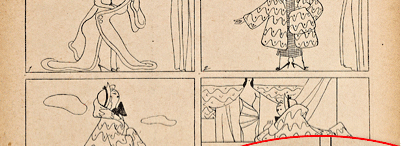 |

Liang Baibo
“Miss Bee”
(detail highlighted in red)
January 1936 [ms25_019] |
| |
Sequences like Wang’s and Liang’s can certainly be interpreted as projections of male anxieties, with the image of the modern girl serving as a metaphor for the threatening, uncontrollable transformations wrought by modernity. At the same time, however, it is important to keep in mind how these cartoons derive their satirical edge from “displaying the display,” thus prompting the reader to think twice about the commodified images of women that saturated print and film media. We see this, for instance, in the way Wang’s modern girl repeatedly looks out at the reader, as if to make sure we are watching, and then ends the sequence with an almost audible “ta-da!” Liang’s sequence “reveals the mechanism” behind commodified displays of gender, this time through a send-up of Shanghai’s “proletarian chic” of the mid-1930s, a time when leftist filmmakers often cast celebrity starlets in working-class roles.[6]
|
|
| |
Visual Narrative: “Modern Girl Modern Boy”
The phenomena of the “modern girl” and “modern boy” swept the world’s urban centers during the interwar years. Shanghai-based Modern Sketch contributors like Zhang Yingchao, Guo Jianying, Hu Kao, Tao Mouji, and Ye Qianyu played a key role in propagating these jazz-age images. The Chinese artists emulated and extended a global style, just as their counterparts in cities like Berlin, Bombay, and Tokyo were doing, creating pictures of play and seduction for a pair of types sometimes worshipped, sometimes reviled, but always in tune with the allure of the modern.
|
|
| |
Such implied critique of the female spectacle is even more apparent in Chen Zhenlong’s long sequence “Contributions of a Photojournalist,” which lampoons the era’s consumer-driven fascination with celebrity lifestyles.
|
|
| |
Chen Zhenlong
“Contributions of a Photojournalist”
(detail highlighted in red)
October 1935 [ms22_055]
|
|
| |
When viewing this sequence, it helps to know that a closely corresponding “day-in-the-life” photo-spread of a modern women in fact appeared in the companion magazine to Modern Sketch, the pictorial Modern Miscellany.[7] By foregrounding the back-story to such visual displays of the modern woman, rather than the image of woman itself, Chen’s cartoon generates ironic distance—a distance that defined the content of Modern Sketch.
|
|
| |
Dai Lian
Woman: Oh my! I heard a noise outside the door again!
Man: And I was sound asleep. Don’t worry, our door couldn’t be stronger!
November 1936 [ms32_003]
|
|
| |
Where “Contributions of a Photojournalist” invites us to construct an entire day by linking 18 separate panels, an untitled cartoon by Dai Lian uses just one panel to point us toward a single dramatic and impending moment. As we have already seen, cartoonists often satirized fellow citizens’ passivity in the face of looming national crisis. Dai Lian’s cartoon revisits this theme by showing us a door separating a couple in a brightly lit, well-appointed bedroom from a pair of sword-bearing, Japanese-robed intruders in the darkness outside. Unlike most single-panel cartoons, which function as static snapshots or windows onto self-contained moments, Dai Lian forces the viewer to form a hypothesis about what will happen next—after the intruders burst through the door. That second, disastrous scene is what satisfies the demand for closure, and leads the viewer to question any misguided confidence in the security of his or her “domestic” space.
When viewing images like Dai Lian’s, it is important to keep in mind that in Modern Sketch, depicting negative social realities aimed less to reflect things as they were than to spur positive change by pointing out, with due exaggeration, how things ought not to be, thus shaming the viewer to higher consciousness. At the same time, the contributors to Modern Sketch did not necessarily feel obliged to take on the grand political crises of their era. Lu Shaofei also encouraged portrayals of simple, everyday misfortunes attributable to modernity in its broadest sense. When it came to sequential cartooning, a recognized master of this approach was the young artist Huang Yao, who won a large following by inflicting good-natured modern mishaps on his pigeon-toed anti-hero W. Buffoon.
In “Call of Tarzan,” for example, Huang plays with the ironic disjuncture between the foreign and the local that transpires when W. Buffoon imitates the latest Hollywood blockbuster to hit China’s treaty-port cinemas. Rather than taking him for the king of the jungle, the residents within earshot mistake W. Buffoon’s bellowing for the arrival of the night-soil collector, and come running with loaded, malodorous wooden “honey buckets.”
|
|
 |
| |
Huang Yao
“Call of Tarzan”
To the housewives and servants of Shangai’s alleyway neighborhoods, comic strip character W. Buffoon’s “call of Tarzan” sounds like the daily morning cry of the night-soil collector.
February 1937 [ms35_044]
|
|
  Another accomplished artist of such pantomime sequences was Huang Jiayin, whose work is easily recognized for his trademark bird signature. In “Sleeping Postures in the Second-class Compartment,” the abstract, iconic line figure encourages readers to identify personally with the modern-day discomforts of rail travel. The temporal twist here is that Huang parenthetically instructs the viewer to “read and repeat.” Another accomplished artist of such pantomime sequences was Huang Jiayin, whose work is easily recognized for his trademark bird signature. In “Sleeping Postures in the Second-class Compartment,” the abstract, iconic line figure encourages readers to identify personally with the modern-day discomforts of rail travel. The temporal twist here is that Huang parenthetically instructs the viewer to “read and repeat.” |
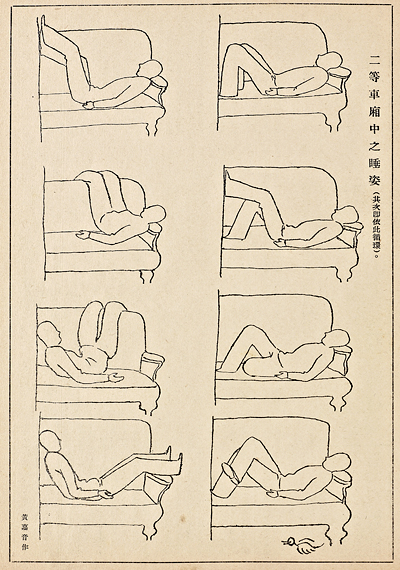
|
 Huang Jiayin Huang Jiayin
“Sleeping Postures
in the Second-class
Compartment”
November 1934
[ms11_010] detail
|
  Huang extends this theme in a sequence pointing out the hazards of combining rail travel with foreign-style dining. Huang extends this theme in a sequence pointing out the hazards of combining rail travel with foreign-style dining. |
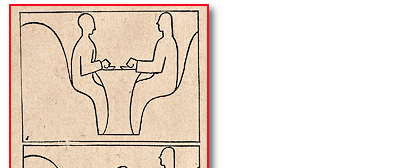 |
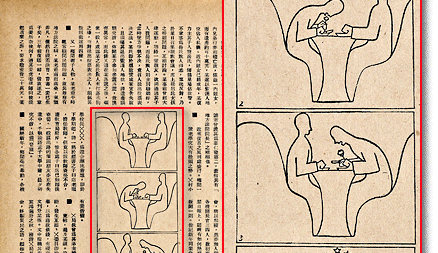 |
 Huang Jiayin Huang Jiayin
“On trains like this,
best to go easy on the
Western food!”
February 1935
[ms14_013]
|
 |
| |
Such abstract figures had other uses, too, especially when it came to narrating critique below the radar of the censors. Where Huang Jiayin’s sparely drawn images of train passengers blur identity to portray a lower-middle-class “everyman,” similarly generalized human forms could be used to convey oblique attacks on authoritarianism.
For example, in Xu Ruoming’s “Noisemaking Forbidden,” naively drawn, iconic figures offer several levels of interpretation. For the many student-age readers of Modern Sketch, the scholar’s gown that the speaker wears, as well as the smaller body size of the audience relative to the speaker, could suggest that Xu is satirizing a middle-school lecture. But for older readers more familiar with political theater, visual elements such as the microphone, the speaker’s excited gestures, and, of course, the machine gun would bring to mind the practice of political oratory during the Republican period. The purported goal of such public speaking was to mobilize the population, typically for patriotic goals. Xu, however, suggests that citizens’ own expression of political views could lead down a deadly one-way street.
|
|
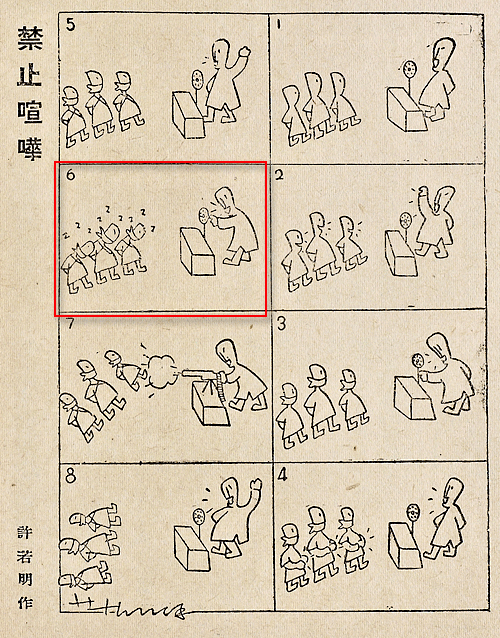 |
| |
Xu Ruoming
“Noisemaking Forbidden”
(with detail highlighted in red)
November 1936 [ms32_030]
|
|
  Panel 6 from Xu’s sequence, when placed alongside a photograph of then-Premier of the Nationalist Government, Wang Jingwei, suggests how readers of the time might recognize political realities in abstractly Panel 6 from Xu’s sequence, when placed alongside a photograph of then-Premier of the Nationalist Government, Wang Jingwei, suggests how readers of the time might recognize political realities in abstractly
drawn cartoons.
The photograph is from the June 1934 issue of Modern Sketch’s sister publication, Van Jan (Wanxiang). The Z’s indicating sleep are one among many imported visual conventions in Modern Sketch cartoons.
(details highlighted in red)
[ms413] Courtesy of Shanghai Library
below, left: detail from above [ms32_032]
|
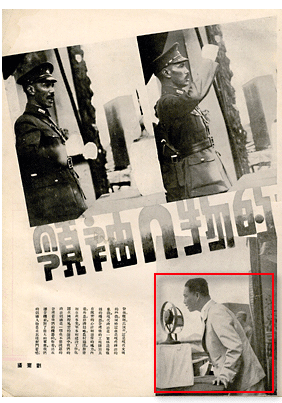 |
| |
Beyond its human figures, Modern Sketch is also a fantastical menagerie inhabited by seductive snakes, cuckold tortoises, “pheasant” prostitutes, and obsequious, foreign-dominated “running dogs.” Conventionalized animal imagery, like that in Zhang Wenyuan’s “World of Beasts,” was often used in non-narrative, multi-panel galleries of social “types.”
|
|
  This detail from Zhang Wenyuan’s twelve-part gallery, “World of Beasts” depicts a nightclub taxi-dancer as a serpentine man-killer. This detail from Zhang Wenyuan’s twelve-part gallery, “World of Beasts” depicts a nightclub taxi-dancer as a serpentine man-killer.
|
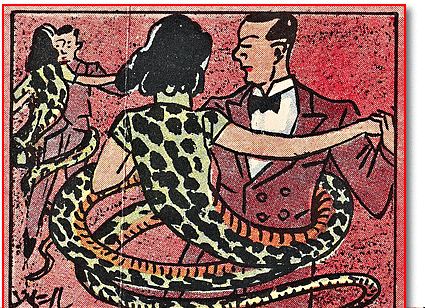 |
| |
Each of the 12 images in this gallery of sin plays off a Chinese idiomatic expression, like “patting the horse’s ass” (flattery), “skinning a live pig” (extortion), and “inflating a cow skin” (boasting and exaggerating).
(detail highlighted in red)
November 1936 [ms32_023]
|
|
| |
Visual Narrative: Modern Grotesque
Many streams of artistic influence fed the imagery of Modern Sketch. Where representations of the “modern girl” and “modern boy” drew mainly from stylish American jazz-age magazine illustration, other cartoonists picked and chose from among modern-art movements like cubism, surrealism, fauvism, and dada. Few rules applied to the young, almost totally uninstitutionalized art of Chinese cartooning, and the results could be fascinatingly grotesque.
|
|

|
| |
In sequential cartoons, animal characters could be used for allegorical, yet deliberately ambiguous, narration of political messages. For instance, Liao Bingxiong’s simplistic style might lead some to read the eight-panel “A Wise Man” as a moral fable against animal abuse. Given Modern Sketch’s emphasis on representing an era, however, the same cartoon also invites a political reading that aligns the relationship between farmer and ox with nearly any form of oppression, large or small, and its potential outcome: rebellion.[8]
|
|
| |
Liao Bingxiong
“A Wise Man”
January 1936 [ms25_014]
|
|
| |
Paper-cuts, Clippings, and Figurines
The paper-cuts, clippings, and figurines appearing in Modern Sketch formed entire new categories of satirical “cartoon” (manhua) art. Artists like Zhang Leping—remembered today for his long and celebrated cartooning career—were adept at the handicraft art of papercutting, which he had learned as a child by watching his mother.[9] Modern Sketch gave Zhang the chance to reinvent this traditional skill, giving it a modern, critical impact quite alien to its origins in festival iconography.
|
|
  Chinese paper-cuts typically featured auspicious patterns with highly conventionalized symbolism. The crane in this traditional-style paper-cut represents longevity, while the word for deer (lu) echoes the word for “official salary.” Chinese paper-cuts typically featured auspicious patterns with highly conventionalized symbolism. The crane in this traditional-style paper-cut represents longevity, while the word for deer (lu) echoes the word for “official salary.”
This image comes from a June 1935 illustrated article on collecting paper-cuts published in the pictorial Van Jan (Wanxiang).
(detail highlighted in red)
Courtesy of Shanghai Library
[ms414]
|
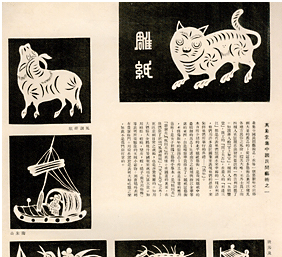 |
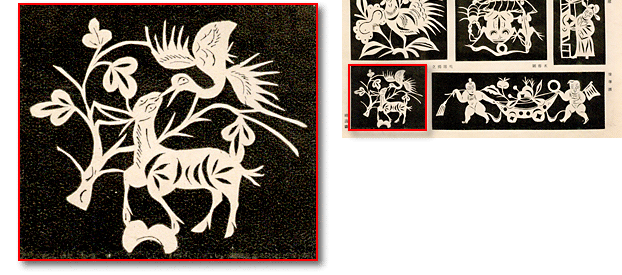 |
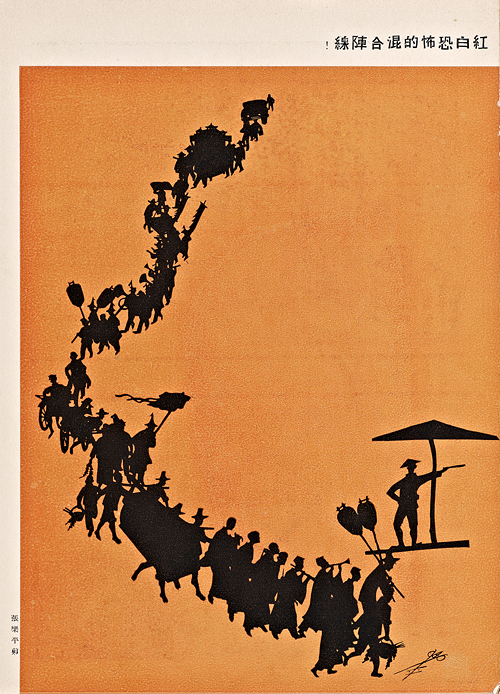 |
| |
Zhang Leping’s paper-cut “The Mixed-up Ranks of Red and White Terror” plays with double meanings of another kind. During the 1930s, Shanghai’s streets could become hopelessly congested by the collision of raucous wedding processions (symbolized by the auspicious color red) with equally noisy funeral processions (traditionally associated with the color white). But red referred to communism as well, while white denoted the Nationalist Government’s program of “white terror” against China's Communist-Party underground. Zhang’s paper-cut suggests that these quite different forms of color-coded activity—the ritual and the political—together created Shanghai’s own distinct brand of urban chaos.[10]
The bride’s sedan chair is visible near the tail end of the procession; the funeral coffin is the foreshortened rectangular shape toward the front. The figure on the platform is a traffic policeman. The diagrammatic figure in the lower right corner is Zhang’s signature, with the two characters for his given name “Leping” drawn to resemble a pair of scissors.
September 1934 [ms09_43]
|
|
  Modern Sketch contributors also experimented with collages of newspaper clippings and other printed materials. To depict a young couple he describes as “squandering their parents’ hard-earned cash on the promotion of urban recreation,” Chen Xiaozuo assembled fragments of newspaper articles, photos of cinema marquees, the betting stub from a horse race (at bottom), and what is likely a love letter. The newspaper articles forming the two human figures report stories about love suicides, “human meat markets,” home-wrecking taxi dancers, and the like. Modern Sketch contributors also experimented with collages of newspaper clippings and other printed materials. To depict a young couple he describes as “squandering their parents’ hard-earned cash on the promotion of urban recreation,” Chen Xiaozuo assembled fragments of newspaper articles, photos of cinema marquees, the betting stub from a horse race (at bottom), and what is likely a love letter. The newspaper articles forming the two human figures report stories about love suicides, “human meat markets,” home-wrecking taxi dancers, and the like. |
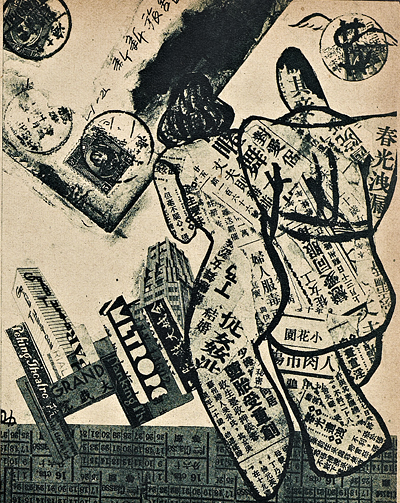 |
  Chen Xiaozuo Chen Xiaozuo
August 1936
[ms29_035] detail
|
| |
The most unusual medium to appear in Modern Sketch were cartoon sculptures and dioramas, called mandiao. These miniatures were reminiscent of the traditional handicraft art of clay figurines, but may also have been inspired by the puppet-like “personettes” invented in the 1930s by American cartoonist and commercial artist Russell Patterson for use in fashion advertising and Hollywood films.[11]
|
|
  In this mandiao diorama, both the God of Wealth figurines and the work’s title, “Waves of Wealth Arrive Year Upon Year,” belong to the realm of auspicious New Year Festival symbolism. However, the words “Republic of China” above the doorway, as well as the rising sun emblem on the deliveryman’s armband and crate of goods, satirize Chinese consumers’ appetite for imports from their imperialist neighbor, Japan. In this mandiao diorama, both the God of Wealth figurines and the work’s title, “Waves of Wealth Arrive Year Upon Year,” belong to the realm of auspicious New Year Festival symbolism. However, the words “Republic of China” above the doorway, as well as the rising sun emblem on the deliveryman’s armband and crate of goods, satirize Chinese consumers’ appetite for imports from their imperialist neighbor, Japan.
Ni Zhicheng
“Waves of Wealth Arrive
Year Upon Year”
(detail highlighted in red)
December 1936 [ms33_037] |
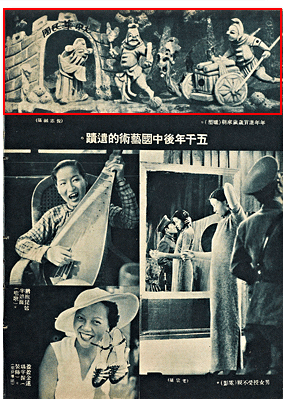 |
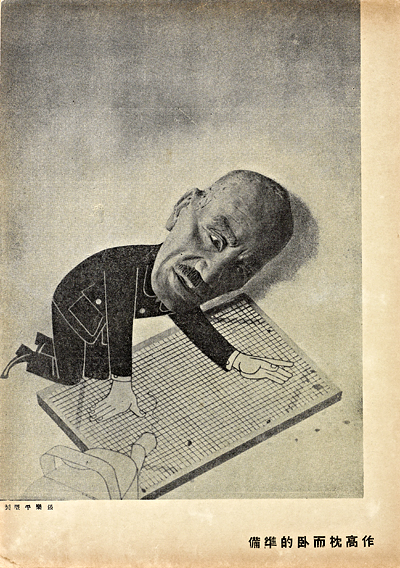
|
   Zhang Leping’s “Preparing for a Peaceful Sleep” features a sculpted head of Chiang Kai-shek above a Go board bereft of the black and white stones used as playing pieces. Zhang’s veiled critique seems aimed at Chiang’s hollow promises to resist Japanese aggression. The object protruding from the lower left is a hot-water carrier, used in cities like Shanghai to fetch bath water from neighborhood hot-water shops. Chiang, it seems, will follow the Chinese custom of bathing before bedtime. Zhang Leping’s “Preparing for a Peaceful Sleep” features a sculpted head of Chiang Kai-shek above a Go board bereft of the black and white stones used as playing pieces. Zhang’s veiled critique seems aimed at Chiang’s hollow promises to resist Japanese aggression. The object protruding from the lower left is a hot-water carrier, used in cities like Shanghai to fetch bath water from neighborhood hot-water shops. Chiang, it seems, will follow the Chinese custom of bathing before bedtime.
Zhang Leping
“Preparing for a
Peaceful Sleep”
September 1934 [ms09_030]
|
| |
|
| |
The big-eared character in this diorama is Zhu Taoshan, the grotesque alter-ego of cartoonist Wang Dunqing. With a half-empty bottle of tranquilizer at his bedside and news headlines announcing the Japanese takeover of China’s northern provinces above him, Zhu Taoshan has just “committed suicide out of despair for the nation.”
(detail enlarged, highlighted in red)
February 1936 [ms26_010]
|
|
| |
In this subsequent mandiao diorama Zhu Taoshan is back among the living, sitting happily in his coffin surrounded by his money after being exiled from Hell for being a troublemaker and a scoundrel. Loosely translated, the title reads, “The ‘Death’ of Zhu Taoshan?”
November 1936 [ms32_033]
|
|
| |
Woodcuts: The True and the Faux
Even though a significant modern woodcut movement paralleled the development of cartooning in China during the 1930s, only three pages of this art form were published in Modern Sketch.[12] It was not that cartoonists looked askance at modern woodcuts (although the opposite may have been true). In fact, Modern Sketch published many pen-and-ink facsimiles of the woodcut style, some executed so convincingly that they were mislabeled “wood engraving” (banhua) in their captions.[13] These faux woodcuts, if we may call them that, demonstrate the innovative borrowing and disregard for convention that made Chinese cartoon art so unpredictably eclectic.
|
|
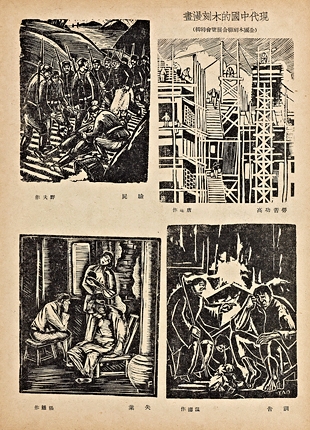 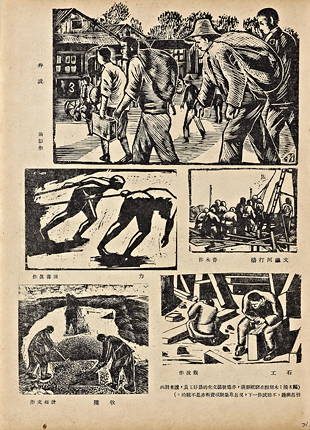 |
| |
“Woodcut Cartoons of Modern China: A Selection
from the National Joint Woodcut Exhibition”
various artists
This two-page spread of woodcuts represents the lion’s share of the genre’s appearance in Modern Sketch. Cartoonists did not ignore modern woodcuts. On the contrary, they experimented with their own pen-and-ink reproductions of the expressionist style and proletarian subjects favored by their colleagues in China’s modern woodcut movement.
October 1935 [ms22_050] [ms22_051]
|
|
  Detail from the second panel in Hu Kao’s five-part graphic narrative “Unemployed” reveals the craftsmanship Hu applied to make his pen-and-ink drawing appear to be a woodcut. The imitation was so convincing that all the images in Hu’s narrative were mislabeled “wood engraving” (banhua). Detail from the second panel in Hu Kao’s five-part graphic narrative “Unemployed” reveals the craftsmanship Hu applied to make his pen-and-ink drawing appear to be a woodcut. The imitation was so convincing that all the images in Hu’s narrative were mislabeled “wood engraving” (banhua).
May 1937 [ms38_15] |
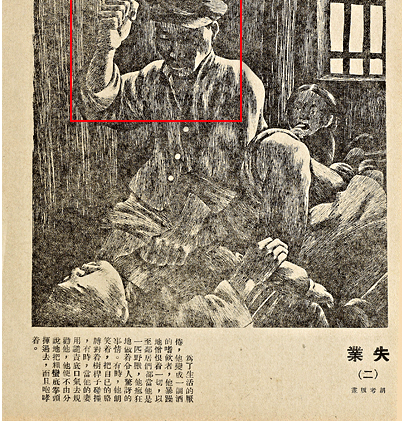 |
| |
Huang Jiayin
“Abandoned Corpse”
Like their contemporaries all over the globe, artists in 1930s China were fascinated by “wordless novels” in woodcut format by European masters such as Frans Masereel (1889-1972). Huang Jiayin’s pen-and-ink “imitation” woodcut, “Abandoned Corpse,” adapts the graphic narrative genre to the streets of Shanghai. The sequence begins in the upper right and reads down and to the left. Like many of China’s modern woodcuts it reflects the brute realities of lower-class existence; in this case, the dilemma poor migrant laborers faced giving proper burial to a family member. [14]
October 1934 [ms10_007] [ms10_008]
|
|
| |
Photography & Photomontage
Second only to single- and multi-panel cartoons, photography and photomontage were the most common forms of visual satire in Modern Sketch. While all the contributors to Modern Sketch were consumers of the richly visual world of pictorial publications, the editorial staff worked in an environment saturated with photographic imagery. The Modern Publications office in fact had a photo studio on the third floor of its building on Shanghai’s Hankou Lu, to which the company would invite celebrities for photo shoots. The company also maintained its photo archive at that address, a resource that the editors of Modern Sketch could and did raid for material to be satirically repurposed.[15]
|
|
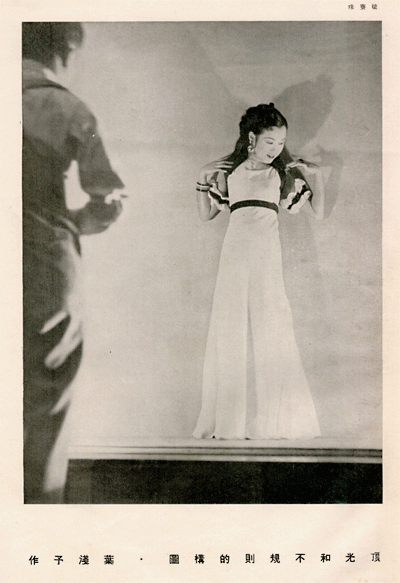
|
  This photo, from the June 1934 issue of Van Jan (Wanxiang), shows a studio shoot of dance and film celebrity Liang Saizhu. The photo is credited to Ye Qianyu, one of the 1930s' most famous cartoonists. The figure in the foreground is probably Ye himself, an avid photographer since the days when he helped edit Modern Sketch’s precursor Shanghai Sketch. This photo, from the June 1934 issue of Van Jan (Wanxiang), shows a studio shoot of dance and film celebrity Liang Saizhu. The photo is credited to Ye Qianyu, one of the 1930s' most famous cartoonists. The figure in the foreground is probably Ye himself, an avid photographer since the days when he helped edit Modern Sketch’s precursor Shanghai Sketch.
Courtesy of Shanghai Library
[ms415]
|
 
One example of such recycling can be traced to the June 1935 issue of Van Jan, which included a photograph by the artist and filmmaker Dan Duyu of a reclining female model, viewed through her crossed legs, and published along with several other nude and semi-nude photos under the title “Composition in Silver-Gray.”
|
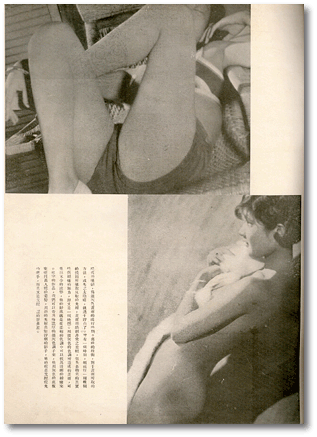 |
Dan Duyu
“Composition in Silver-Gray”
Courtesy of Shanghai Library
[ms416] |
| |
20 months later the photograph reappeared, this time uncredited, in the February 1936 issue of Modern Sketch as part of the photo-spread “A True and Authentic Exhibition of National Goods.” Movements to promote China’s national goods (guohuo) had been ongoing since 1905 as a means to resist foreign domination of the Chinese economy. Led by patriotic elites, efforts to encourage people to buy Chinese-made versions of imports proved largely ineffective, with consumers tending to prefer foreign-made products over frequently shoddy domestic items.[16]
The Modern Sketch lampoon of national goods takes such patriotic hypocrisy to task, labeling a pair of coins “Our Binoculars,” a female dwarf “Our Typical Beauty,” a beggar chalking his sorrows on the sidewalk “Our Great Literary Giant,” a caged songbird “Our Modern Woman,” and an exhumed skeleton “Our Everlasting Hero of the Resistance.” Juxtaposed photos of race-course gamblers and soup-kitchen refugees are described as “Our Two Types of People,” and, finally, Dan Duyu’s photo is revisited with a dose of acid humor under the caption “Our Film Star.”
|
|
 |
| |
“A True and Authentic Exhibition of National Goods”
The editorial team at Modern Sketch frequently repurposed file photos for humorous and satirical ends. This spread takes a cynical dig at the “national goods” movements promoted during the early decades of the 20th century, labeling a caged bird “Our Modern Woman,” an exhumed skeleton “Our Everlasting Hero of the Resistance,” and so on. The pseudonymous credit “Yi Liu” plays on a homophone for the word “top quality”—a backhanded reference to the shoddiness of some of China’s domestic manufactured goods.
(detail highlighted in red)
February 1936 [ms26_011]
|
|
| |
The meaning of photographs could also be destabilized through juxtaposition, most frequently by mounting one half-page image atop another and adding a droll title. One of the more striking examples of this technique is “40 Years of Chinese Women’s Liberation: Before-and-After,” which sets a late-Qing dynasty photographic portrait of a courtesan above a 1930s image of a celebrity songstress, the latter simpering for the camera while cradling an instrument then popular in the U.S. and Europe, a mandolin-banjo.
|
|
| |
“40 Years of Chinese Women’s Liberation: Before-and-After”
March 1937 [ms36_036]
|
|
| |
Courtesans—young women trained as professional entertainers to attract the patronage of elite urban men—were among the first in China to exploit the commercial potential of photography, using their portraits as a means of advertising during their heyday in the late-19th and early-20th centuries.[17] Foregrounded here, of course, are the many continuities between the old and new images, prompting the viewer to question what lay underneath the flashy and alluring, but often very thin, veneer of modern Chinese urban life.
|
|
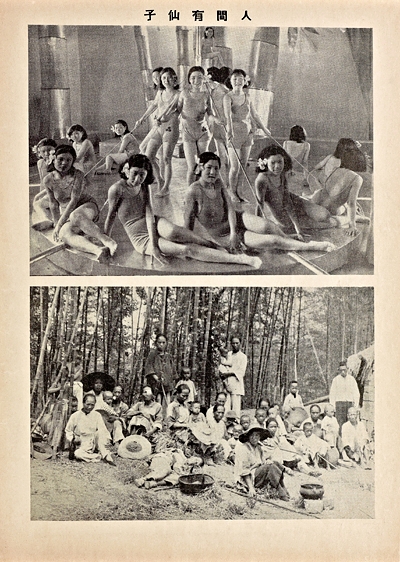 |
   For contributors to Modern Sketch, the shallow, uneven experience of modernity was most evident when comparing city to country. If the courtesan-starlet pairing points up ironic correspondences across time, the over-under shots entitled “Female Immortals Among Us” stress the vast gap between urban and rural lives by juxtaposing a constellation of bathing beauties, arrayed on a modernistic stage set, with a grim tableau of destitute refugee women. For contributors to Modern Sketch, the shallow, uneven experience of modernity was most evident when comparing city to country. If the courtesan-starlet pairing points up ironic correspondences across time, the over-under shots entitled “Female Immortals Among Us” stress the vast gap between urban and rural lives by juxtaposing a constellation of bathing beauties, arrayed on a modernistic stage set, with a grim tableau of destitute refugee women.
|
 “Woman Female Immortals “Woman Female Immortals
Among Us”
November 1934 [ms11_015] |
| |
The cut-and-paste approach of photomontage also lent itself to the satirical manipulation of geographic space within the city itself. Zhao Dingming’s montage “The Future Shanghai Racecourse: Equal Treatment for High-rises and Hovels” artificially closes the yawning economic gap that separated Shanghai’s prosperous central thoroughfare, Bubbling Well Road (today’s Nanjing West Road), from the sprawling shantytowns on the city’s margins. The tongue-in-cheek caption adopts a journalistic tone, reporting how “Chinese and foreigners alike praise the slum-dwellers’ energetic efforts to become members of the flourishing city after being forcibly removed from the eastern district.”
|
|
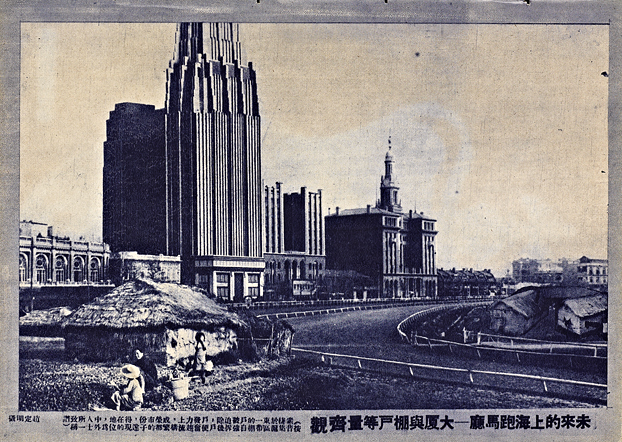 |
| |
The four landmark buildings in the background of this photo still stand in Shanghai today. Built between 1926 and 1934, they are, from left to right, the Grand Theater, the 22-story Park Hotel, the foreign YMCA, and China United Apartments. The shacks have been pasted onto the race course, now the site of People’s Park.
May 1937 [ms38_011]
|
|
  As we have already seen, Modern Sketch made extensive use of images of women to expose social contradictions. More often than not, women represented the excesses of urban life, often in harsh contrast to the deprivation of China’s interior. As we have already seen, Modern Sketch made extensive use of images of women to expose social contradictions. More often than not, women represented the excesses of urban life, often in harsh contrast to the deprivation of China’s interior. |
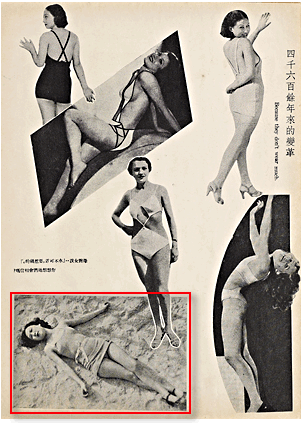
|
   Images of women in the earlier issues of Modern Sketch, as in this July 1934 photospread, were almost pure cheesecake. The woman lying on the sand is China’s 1930s swimming star Yang Xiuqiong. Images of women in the earlier issues of Modern Sketch, as in this July 1934 photospread, were almost pure cheesecake. The woman lying on the sand is China’s 1930s swimming star Yang Xiuqiong.
(detail highlighted in red)
July 1934 [ms07_016]
|
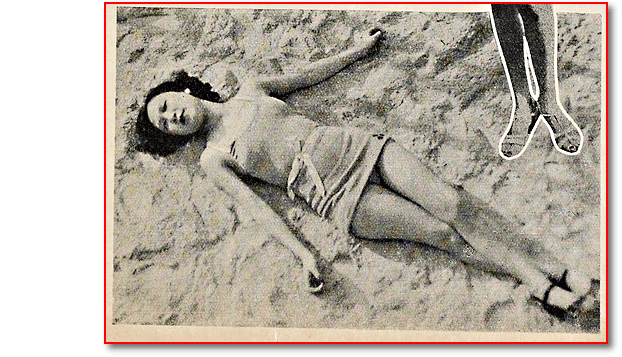 |
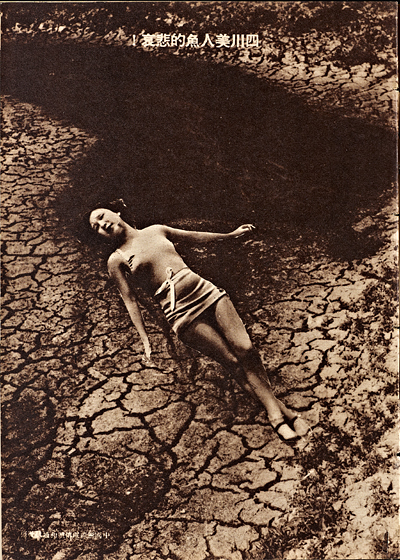
|
  When it came to photomontage, stock images of beautiful female celebrities were ripe pickings for this kind of treatment, especially in the magazine’s later issues. For instance, an image of China’s aquatic sports star Yang Xiuqiong that appeared in a cheesecake spread in 1934 reappeared in a quite different context three years later. A pair of scissors, a pot of glue, and access to the Modern Publications photo archives was all it took to transport her from a warm sandy beach to the parched earth of the drought-stricken, inland province of Sichuan. When it came to photomontage, stock images of beautiful female celebrities were ripe pickings for this kind of treatment, especially in the magazine’s later issues. For instance, an image of China’s aquatic sports star Yang Xiuqiong that appeared in a cheesecake spread in 1934 reappeared in a quite different context three years later. A pair of scissors, a pot of glue, and access to the Modern Publications photo archives was all it took to transport her from a warm sandy beach to the parched earth of the drought-stricken, inland province of Sichuan. |
  “Sorrows of a Sichuan Mermaid!” From Modern Sketch, April 1937. “Sorrows of a Sichuan Mermaid!” From Modern Sketch, April 1937.
The image is speciously credited
to the “China Wireless
Photographic News Service.”
April 1937 [ms37_010] |
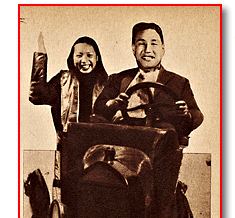 |
  Photomontage was also used to manipulate identity. The motive for doing so could be purely frivolous, as when the heads of Chinese film stars Jin Yan and Wang Renmei were glued onto what was probably a still image of Laurel and Hardy driving a beat-up Model-T Ford. Photomontage was also used to manipulate identity. The motive for doing so could be purely frivolous, as when the heads of Chinese film stars Jin Yan and Wang Renmei were glued onto what was probably a still image of Laurel and Hardy driving a beat-up Model-T Ford. |
 photomontage photomontage
(detail highlighted in red)
February 1936 [ms26_035]
|
| |
But montage artists also took aim at larger targets, including modern Chinese identity itself. By far the most ambitious example of photomontage in Modern Sketch was the anthropomorphous cut-and-paste catalogue of the era’s ills and anxieties, “The Typical Chinese Person.”
|
|
| |
“The Typical Chinese Person”
January 1936 [ms25_020] |
|
| |
Imperialism, censorship, war, Chinese heritage, Western imports, industrialization, money-worship...all are pictured here in an absurd but arresting assemblage, one that challenges the viewer to separate calamity from humor, indignation from amusement, and the trauma of victimization from the pleasures of clever invention. If any one image can represent the motley democracy of forms that is Modern Sketch, this would be it. Nothing quite like this magazine, or the era it sought to portray, has been seen in China since.
|
|
| |
Visual Narrative: Eroticized Women
Almost every major cartoonist who contributed to Modern Sketch, including the editor Lu Shaofei, tried his hand at erotic depictions of women. “Eating ice cream with the eyes” was the local slang expression for viewing such images, which in many ways resonated with the golden age of pin-up girl illustration in the United States that was happening at the very same time. Often these nude and semi-nude images came with a political subtext. Sometimes they were simply attention-grabbing ploys to increase circulation. For all their diversity of style, and whatever their ultimate intent, these erotic illustrations and photographs leave no doubt that Modern Sketch was very much a magazine by and for men.
|
|
|





